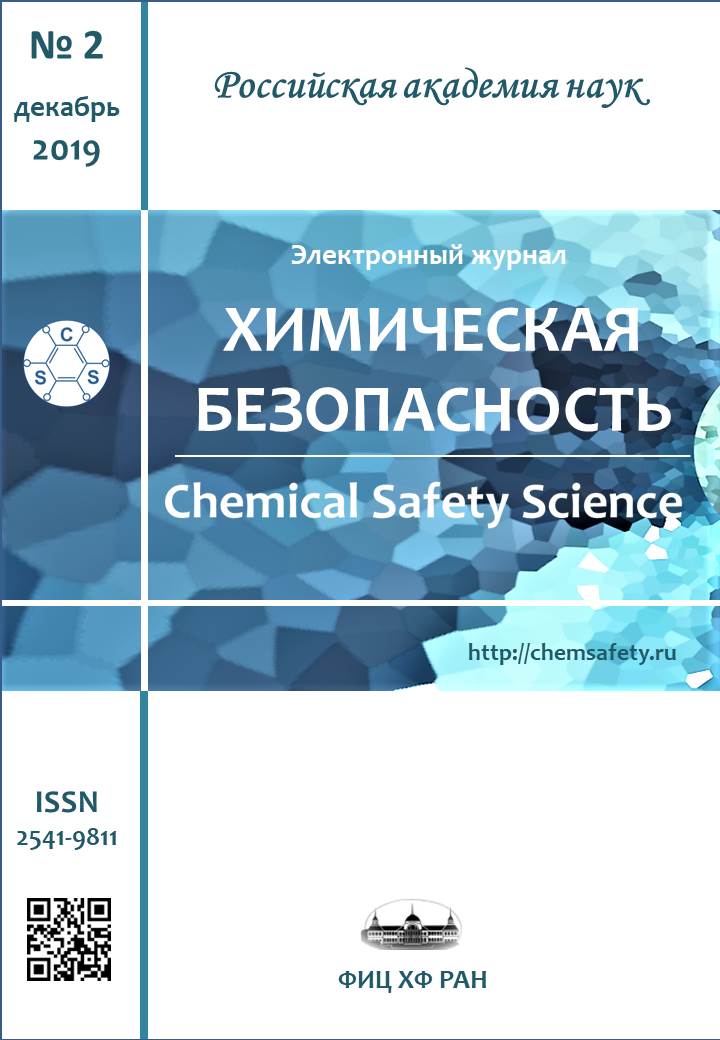Oxidative Destruction of Organic Compounds by Fenton’s Reagent in Industrial Wastewater Treatment
Abstract
Chemical oxidation is widely recognized as one of the most reliable ways of decontamination of toxic organic compounds which can occur in industrial wastewater. In particular, Fenton's reagent – a catalytic system based on hydrogen peroxide combined with iron (II) ions – has proven effective for oxidizing the most toxic and persistent organic pollutants. The paper presents results of laboratory experiment on treating industrial wastewater samples with Fenton’s reagent under both static and aerated conditions as exemplified on a number of individual anthropogenic organic pollutants of different nature. Dynamics of reducing concentrations of toxicants resulting from Fenton’r reagent-driven purification under various conditions is presented. Thus, oxidation under aeration has enhanced the increase of efficiency of wastewater treatment from 72.2 to 96.8%. Concurrently, the proposed water treatment method has improved organoleptic properties of the treated samples as evidenced from the results of vapor phase analysis. The treatment procedure has led to registration of acetaldehyde alone in the treated sample, with its 40-fold level decrease relative to its initial content in the sample.
References
Liu H., Chen Q., Yu Y. et al. // Journal of Hazardous Materials. 2013. V. 263. P. 593. DOI: https://doi.org/10.1016/j.jhazmat.2013.10.021.
Manzano M.A., Perales J.A., Sales D., Quiroga J.M. // Water, Air, and Soil Pollution. 2004. V. 154. No. 1-4. P. 57. DOI: 10.1023/B:WATE.0000022931.58418.90.
Barbusinski K. // Ecological chemistry and engineering S. 2009. V. 16. No. 3. P. 347.
Zhelovitskaya A.V., Dresvyannikov A.F., Chudakova O.G. // Vestnik tekhnologicheskogo universiteta [Bulletin of Technological University].2015. V. 18. No. 20 P. 73 [in Russian].
Ebrahiem E.E., Al-Maghrabi M.N., Mobarki A.R. // Arabian Journal of Chemistry. 2017. No. 10. P. S1674. DOI: https://doi.org/10.1016/j.arabjc.2013.06.012.
Pawar V., Gawande S. // IOSR Journal of Mechanical and Civil Engineering (IOSR-JMCE). 2015. V. 2. (Innovation in engineering science and technology (NCIEST-2015). P. 127.
Charron I., Couvert A., Laplanche A., Renner C. et al. // Environ. Sci. Technol. 2006. V. 40. No. 24. P. 7881. DOI: https://doi.org/10.1021/es060414d.
Walling C. // Accounts of Chemical Research. 1975. V. 8. No. 4. P. 125. DOI: https://doi.org/10.1021/ar50088a003.
Changotra R., Rajput H., Dhir A. // J. Photochem. Photobiol. A: Chemistry. 2019. V. 376. P. 175. DOI: 10.1016/j.jphotochem. 2019.02.029.
Tyre B.W., Watts R.J., Miller G.C. // Environmental Quality. 1991. V. 20. No. 4. Р. 832. DOI: 10.2134/jeq1991.00472425002000040021x.
Badawy M.I., Ali M.E.M. // Journal of Hazardous Materials. 2006. V. B136. P. 961. DOI: 10.1016/j.jhazmat.2006.01.042.
Hermosilla D., Merayo N., Ordonez R., Blanco A. // Waste Management. 2012. V. 32. No. 6. P. 1236. DOI: 10.1016/j.wasman.2011.12.011.
Savelieva E.I., Gavrilova O.P., Gagkaeva T.Yu. // J. Analytical Chem. 2014.V. 69. No. 7. P. 609. DOI: 10.1134/S1061934814050086.
Ruth J.H. // Am. Ind. Hyg. Assoc. J. 1986. V. 47. No. 3. P. A142. DOI: 10.1080/15298668691389595.
Talaiekhozani A., Bagheri M., Goli M., Reza M. Khoozani T. // Journal of Environmental Management. 2016. V. 170. P. 186. DOI: http://dx.doi.org/10.1016/j.jenvman.2016.01.021.
Zhang X.L., Yan S., Tyagi R.D., Surampalli R.Y. // Journal of Environmental Management. 2013. V.124. P. 62. DOI: https://doi.org/10.1016/j.jenvman.2013.03.022.
Pignatello J.J., Oliveros E., MacKay A. // Crit. Rev. Environ. Sci. Technol. 2006. V. 36. P. 18. DOI: 10.1080/10643380500326564.
Gernjak W., Krutzler T., Malato S., Bauer R. // J. Sol. Energy Eng. 2007. V. 129. P. 53. DOI: 10.1115/1.2391132.
de Souza D.R., Duarte E.T.F.M., de Souza Girardi G. et al. // J. Photochem. Photobiol. A: Chem. 2006. V. 179. P. 269. DOI: 10.1016/J.JPHOTOCHEM.2005.08.025.
Ganzenko O., Huguenot D., van Hullebusch E.D., Esposito G., Oturan M.A. // Environ. Sci. Pollut. Res. 2014. V. 21. P. 8493. DOI: 10.1007/s11356-014-2770-6.
Ahmadzadeh S., Dolatabadi M. // Environ. Earth Sci. 2018. V. 77. P. 53. DOI: 10.1007/s12665-017-7203-7.
Copyright (c) 2019 I. A. Vasilieva, L. K. Gustyleva, N. A. Samchenko, A. I. Ukolov, and E. I. Savelieva

This work is licensed under a Creative Commons Attribution-NonCommercial 4.0 International License.












